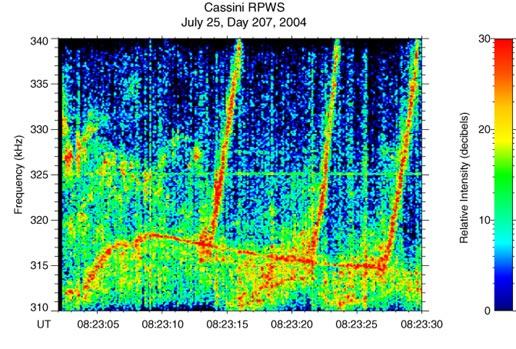Bizarre Sounds of Saturn’s Radio Emissions

| PIA Number | PIA07967 |
|---|---|
| Language |
|
Click here to play sounds of Saturn's radio emissions, which have changes in frequency (127Kb Wave Sound).
Saturn is a source of intense radio emissions, which have been monitored by the Cassini spacecraft. The radio waves are closely related to the auroras near the poles of the planet. These auroras are similar to Earth's northern and southern lights. This is an audio file of Saturn's radio emissions.
The Cassini spacecraft began detecting these radio emissions in April 2002, when Cassini was 374 million kilometers (234 million miles) from the planet, using the Cassini radio and plasma wave science instrument.
The instrument has now provided the first high resolution observations of these emissions, showing an amazing array of variations in frequency and time. In this example, it appears as though the three rising tones are launched from the more slowly varying narrowband emission near the bottom of this display. If this is the case, it represents a very complicated interaction between waves in Saturn's radio source region, but one which has also been observed at Earth.
Time on this recording has been compressed such that 13 seconds corresponds to 27 seconds. Since the frequencies of these emissions are well above the audio frequency range, we have shifted them downward by a factor of 260.
The Cassini-Huygens mission is a cooperative project of NASA, the European Space Agency and the Italian Space Agency. The Jet Propulsion Laboratory, a division of the California Institute of Technology in Pasadena, manages the mission for NASA's Science Mission Directorate, Washington, D.C. The Cassini orbiter was designed, developed and assembled at JPL. The radio and plasma wave science team is based at the University of Iowa, Iowa City.
For more information about the Cassini-Huygens mission, visit http://saturn.jpl.nasa.gov and the instrument team's home page, http://www-pw.physics.uiowa.edu/cassini/ .
Credit: NASA/JPL/University of Iowa
